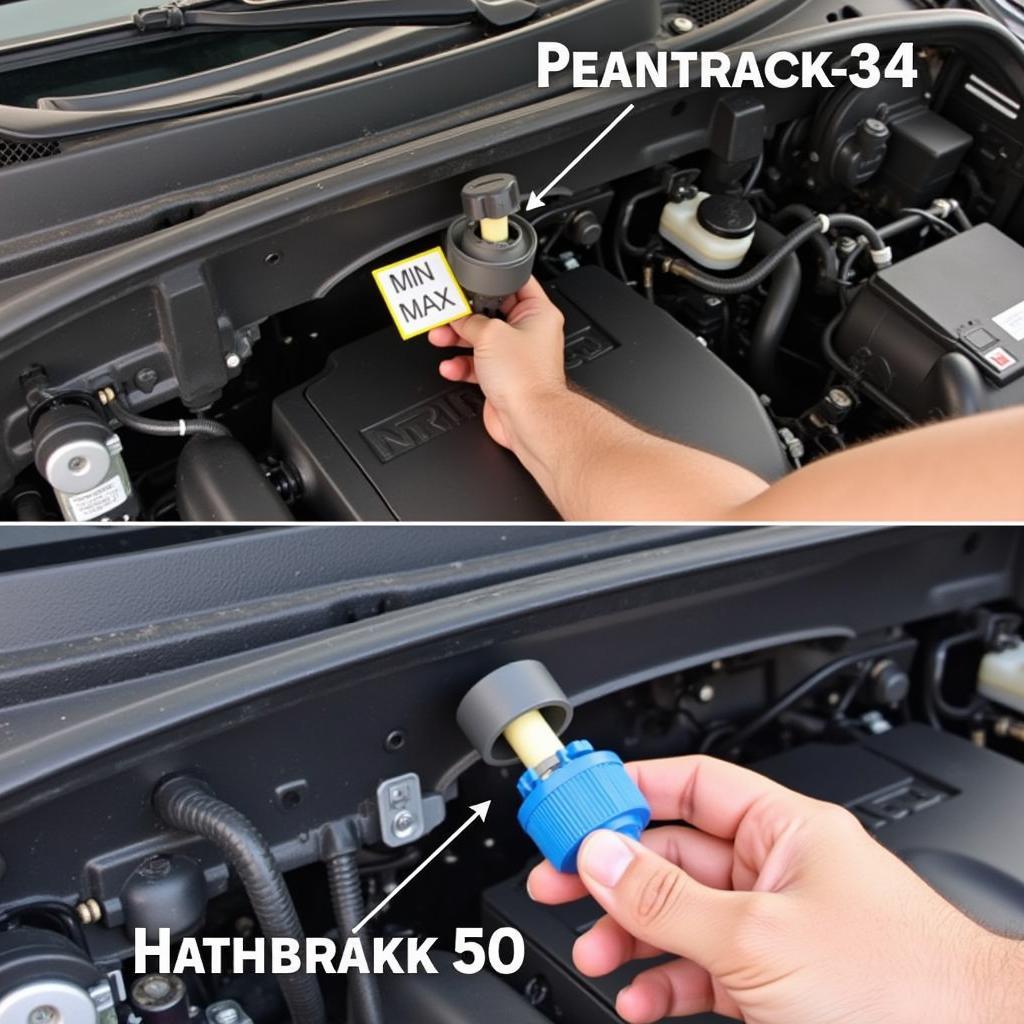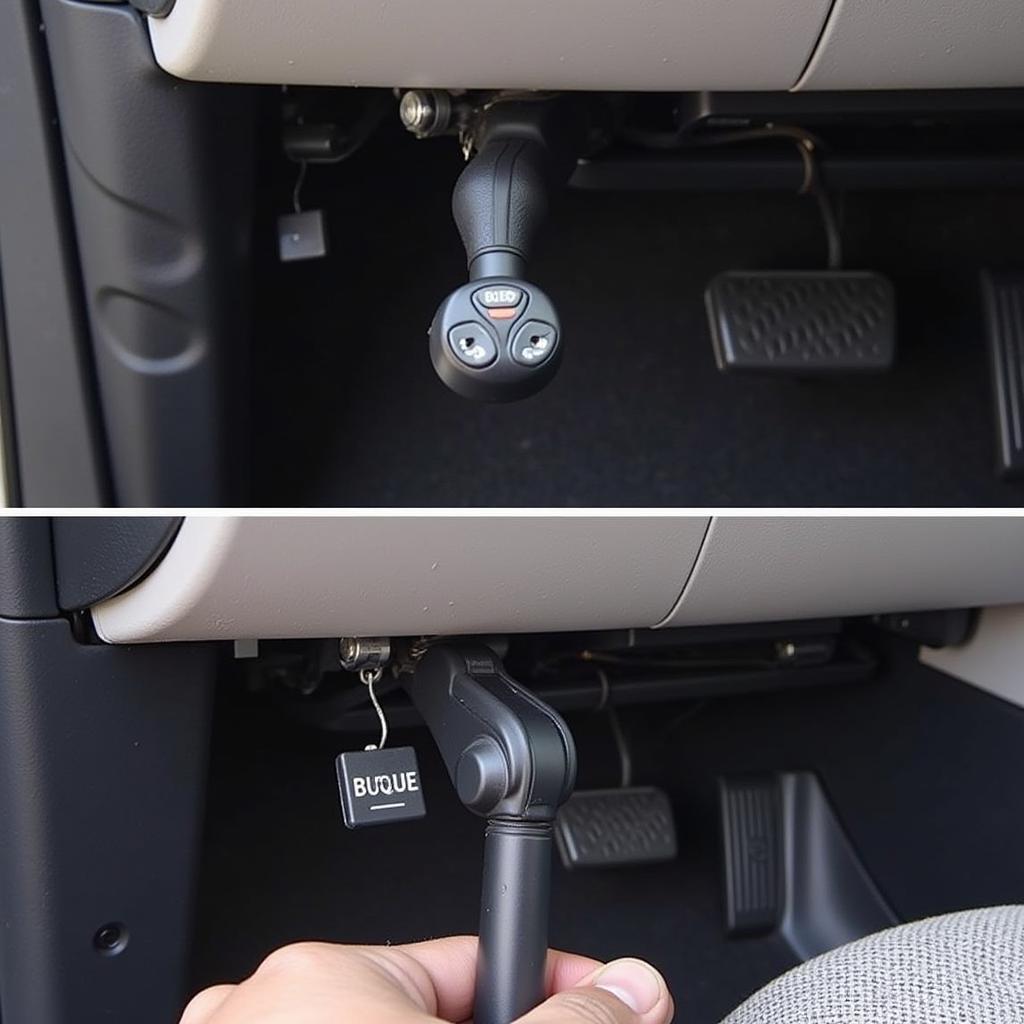The brake warning light on your Toyota Tundra can be a source of anxiety, but understanding its causes and solutions can empower you to address the issue effectively. This guide will walk you through common reasons why your Tundra’s brake warning light might be on, from simple fixes to more complex problems requiring professional attention.
Understanding Your Tundra’s Brake Warning Light
The brake warning light is part of your Tundra’s safety system. It illuminates for several reasons, not all of which indicate a serious problem. However, ignoring it could lead to significant safety risks and potentially costly repairs. A lit brake warning light can indicate low brake fluid, a problem with the anti-lock braking system (ABS), a faulty parking brake, or worn brake pads. Let’s dive deeper into each of these possibilities.
Low Brake Fluid: A Common Culprit
One of the most frequent causes of the brake warning light is low brake fluid. This usually indicates a leak somewhere in the braking system. Checking your brake fluid level is a simple task. Locate the brake fluid reservoir under the hood, usually a translucent plastic container. The “MIN” and “MAX” markings indicate the acceptable fluid level. If the level is below “MIN,” add the correct type of brake fluid, as specified in your owner’s manual. Important: Do not drive if the fluid is significantly low, as this could compromise your braking ability. If you frequently need to add brake fluid, have a professional mechanic inspect the system for leaks.
 Checking the Brake Fluid Reservoir in a Toyota Tundra
Checking the Brake Fluid Reservoir in a Toyota Tundra
ABS Issues: More Than Just a Light
The brake warning light can also indicate a problem with your Tundra’s Anti-lock Braking System (ABS). The ABS prevents wheel lockup during hard braking, allowing you to maintain steering control. A malfunctioning ABS can be caused by a faulty sensor, a problem with the ABS module, or a wiring issue. While you can sometimes continue driving with a faulty ABS, it’s crucial to have it inspected and repaired as soon as possible to ensure optimal braking performance in emergency situations.
Parking Brake Engaged: An Easy Fix
Sometimes the simplest solution is the right one. Make sure your parking brake isn’t engaged. It might seem obvious, but it’s a common oversight that can trigger the brake warning light. If the light remains on after releasing the parking brake, there might be a problem with the parking brake switch or cable.
 Toyota Tundra Parking Brake Lever
Toyota Tundra Parking Brake Lever
Worn Brake Pads: Time for a Change
Worn brake pads are another common cause of the brake warning light. Most modern vehicles, including the Toyota Tundra, have wear sensors embedded in the brake pads. These sensors trigger the warning light when the pads reach a certain level of wear. Ignoring this warning can lead to damage to the rotors and other brake components, resulting in more extensive and expensive repairs. If you suspect worn brake pads, have them inspected and replaced by a qualified mechanic.
Remote Diagnostics and Software Solutions: A Modern Approach
“With advancements in automotive technology, remote diagnostics and software updates are becoming increasingly important in resolving brake warning light issues,” states John Miller, Senior Automotive Electrical Engineer at AutoTech Solutions Inc. “We can often identify and fix software glitches related to the ABS or other braking systems remotely, saving the customer time and money.”
Conclusion: Addressing the Brake Warning Light in Your Toyota Tundra
The brake warning light in your Toyota Tundra should never be ignored. While it can sometimes indicate a simple issue like low brake fluid or an engaged parking brake, it can also signal more serious problems with your braking system. Addressing the issue promptly can prevent further damage and ensure your safety on the road. If you are unsure about the cause of the warning light, it’s always best to consult a qualified mechanic or consider remote diagnostic services for a quick and convenient solution. Don’t delay – take action to address your Toyota Tundra brake warning light today.
FAQ
-
What should I do if my Toyota Tundra’s brake warning light comes on while driving? Safely pull over to the side of the road and check your parking brake. If it’s not engaged, check your brake fluid level. If the fluid is low, add more if you have it, but proceed with caution. If the light remains on, have your vehicle towed to a mechanic.
-
How often should I check my brake fluid level? It’s a good practice to check your brake fluid level at least once a month.
-
Can I drive my Toyota Tundra with the ABS light on? You can usually drive with the ABS light on, but your ABS functionality will be disabled. Have it inspected and repaired as soon as possible.
-
How long do brake pads last on a Toyota Tundra? Brake pad lifespan varies depending on driving habits and conditions, but they typically last between 30,000 and 70,000 miles.
-
What is the cost of replacing brake pads on a Toyota Tundra? The cost varies depending on location and the specific parts used, but you can expect to pay between $200 and $400 for a typical brake pad replacement.
-
Is it safe to ignore the brake warning light? No, it is never safe to ignore the brake warning light. Ignoring it could lead to brake failure and a serious accident.
-
Can remote diagnostics fix my Toyota Tundra’s brake warning light issue? In some cases, yes. Remote diagnostics can identify and fix software-related problems within the braking system. However, physical problems will still require hands-on repair.

